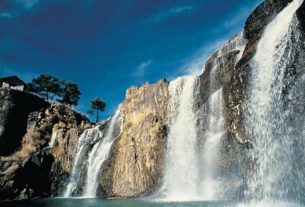The Grand Canyon is one of the most impressive natural spectacles in the world. The gigantic gorge, which the Colorado River has dug into the stone 1,800 m deep over a length of 350 km in millions of years, is an open book of the last 2 billion years of geological history. The almost 5000 km² national park is located in the northwest of Arizona.
Grand Canyon National Park: Facts
| Official title: | Grand Canyon National Park |
| Natural monument: | Protected since 1908, national park since 1919 and existing in today’s area of 4930.77 km² since 1975; the Grand Canyon is spectacular, a 447 km long canyon created by the Colorado River with north and south rims |
| Continent: | America |
| Country: | USA, Arizona |
| Location: | Coconino and Mohave Counties, in northern Arizona |
| Appointment: | 1979 |
| Meaning: | a “geological history book” of the last two billion years and with a depth of almost 1500 m one of the most spectacular gorges in the world |
| Flora and fauna: | Colorado firs, hard spruce, American quivering aspen, yellow pines and the juniper species Juniperus osteosperma as well as more than 1,500 identified plant species from five of the seven North American vegetation zones, including eleven plant species considered to be endangered; over 300 bird and 76 mammal species, including peregrine falcons and brown pelicans; also coyotes, mountain lions, mule deer, pronghorns, bighorn sheep, elk deer, bobcats and kai squirrels, which are only found on the North Rim |
An open book on the history of the earth
It belongs to the image of the USA like skyscrapers to Manhattan and road cruisers to the American highways, and the French writer Simone de Beauvoir once admitted to having dreamed of this place for a long, very long time: she was interested in the Grand Canyon, that unique wonder of the world in Arizona in the US Southwest, as.
The gigantic crevice is like an open book in which one can read over two billion years of the earth’s history. At the bottom of the deep bed that the Colorado River has created here, some of the oldest rocks on earth are visible, granite and shale formations, the age of which is given as 1.7 billion years; they are therefore half the age of planet earth – statistics that fit the gigantism of the natural wonder and the land of unlimited possibilities. Rock layer on rock layer, whether lava, limestone, sandstone, slate or granite, is visible as part of the earth’s crust., noted Simone de Beauvoir in her travel diary.
The Grand Canyon is such a striking landscape that the astronauts of Apollo 11 could see the huge crevice from space with the naked eye. Even those who cannot see the gorge and the panorama of the rock domes from this spectacular perspective are hardly less impressed: The daily course of the sun constantly changes the picture, conjures up new and unforgettable impressions when the gigantic, colorful backdrop in beige, brown and in front revealed to all red. And often the canyon appears just like in the famous painting by Thomas Moran “The Chasm of the Colorado” (“Die Klamm des Colorado”, 1874): a dream landscape under great cloud formations and with wafts of mist on the mountains, the names like “Walhalla” and wear “dragon head”. One believes there are even mysterious temples in the rocks.
The crack extends 1700 m deep into the earth. If you want to hike the 446 km long canyon, you should be aware that it crosses six of the earth’s seven climate zones – from the alpine climate to the desert climate. The descent to the Colorado River, which then no longer shows itself as a narrow trickle like from the edge of the canyon, but as a wild river, means trekking at up to 48 ° Celsius. If 30 ° Celsius is measured in summer on the much-visited South Rim, which is 300 m below the northern edge, the North Rim reports up to 24 ° Celsius at most. And if there is still snow on the southern edge, the thermometer at the bottom of the gorge already shows 22 ° Celsius.
The Native American Indians called the place “water that penetrates the earth” and “descent into the underground”. The Spaniards, on the other hand, recognized “mountains higher than Seville Cathedral” in northwest Arizona, and the missionary Tomàs Garcés named the river in the canyon “Río Colorado” (“Red River”) because of its reddish color. If you look down into the gorge today, you will only see a bottle-green body of water – a dam was built upstream in 1963, which has since held back the red sand that once spectacularly colored the river.
The US officer who mapped the Grand Canyon in 1857 seemed unimpressed by the “wonder of the world”: As is well known, the man was wrong: Today this natural wonder counts five million visitors a year. This is entirely in the spirit of US President Theodore Roosevelt, at whose instigation in 1908 almost 5000 km² of the canyon were elevated to a national monument because he recognized it as “the undisputed greatest attraction” “that every American should have seen.” After the establishment of a national park in 1919, many millions marveled at the stony history of the earth and polished many of the rocky vantage points with their feet.
It may still be possible to steer mass tourism in a sensible direction, but the fight against the air pollution that has occurred, which has been clouding the view at the Grand Canyon for some time, seems hopeless: Emissions from copper smelters and road traffic in the greater Los Angeles area cause haze days at best can still see 30 km away.



